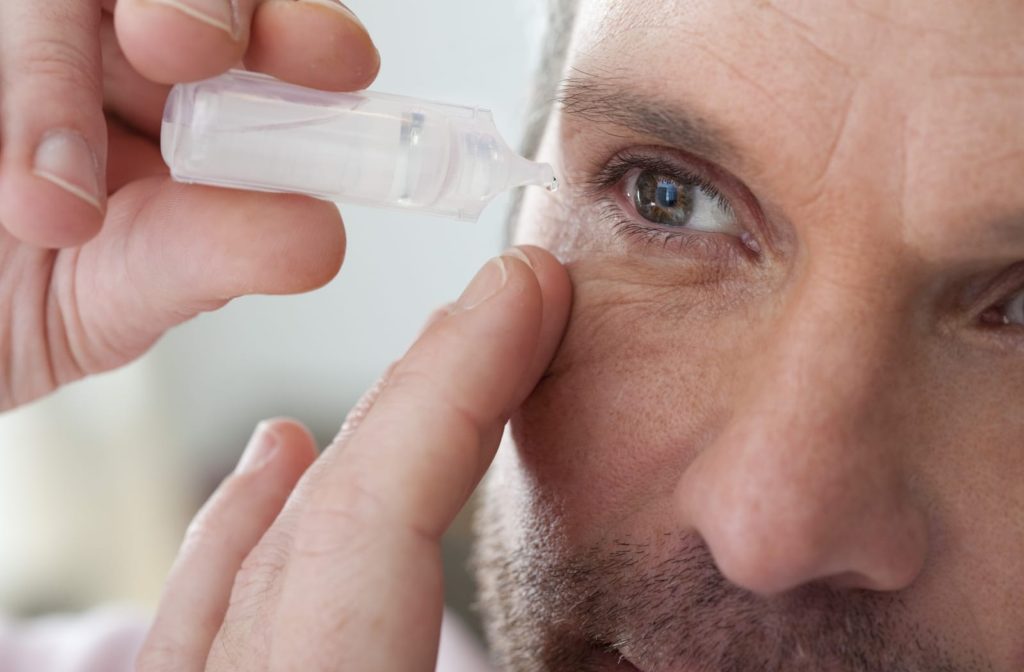There are options a-plenty available for dealing with dry eye syndrome! Depending on how your symptoms are caused, whether it’s through evaporative dry eye or aqueous tear deficiency, your optometrist can help you find the solutions that suit you best.
Some of the most commonly used treatments for dry eyes are eye drops. However, despite how simple they may be, there is so much to eye drops than what meets the eye. Today, we’re going to dive into the world of eye drops and answer your questions so you and your optometrist can make the right choice for you and your eyes.

What Can Cause Dry Eyes?
Before we can jump into the deep end of eye drops, we first need to have a little refresher of what can cause dry eyes. Practically everybody can explain the experience of dry eyes; itchiness, redness, and wateriness are some of the most common symptoms; but not everyone understands what can cause dry eyes in the first place.
There are 2 types of dry eye you can experience: evaporative dry eye or aqueous tear deficiency.
Evaporative Dry Eye
Evaporative dry eye can occur with the development of eye conditions like meibomian gland dysfunction and blepharitis. These conditions prevent the production of a healthy lipid layer to your tear film, causing dry eye symptoms.
Aqueous Tear Deficiency
Aqueous tear deficiency occurs when your lacrimal glands aren’t producing an adequate amount of water to your tear film, resulting in dry eyes. Aqueous tear deficiency can also cause hyperosmolarity to your tear film, which can damage your cornea over time.

The Difference Between Preservative & Non-Preservative Eye Drops
Some of the terms you may hear regarding eye drops are whether they have preservatives or not. Preservatives are chemicals put into the eye drop that helps prevent the growth of bacteria in the bottle after you’ve opened it.
Optometrists recommend these drops for patients with mild dry eyes, as these chemicals could irritate your eyes if you have moderate or severe symptoms.
Choosing Your Eye Drops
Eye drops are some of the most used treatments for dry eyes. Because of this, there are thousands of different products available to help dry eye symptoms.
But how do you know which ones are right for you? We’ve broken eye drops down into 2 simple groups, over-the-counter eye drops and prescription eye drops.
Over-The-Counter (OTC) Eye Drops
Over-the-counter (OTC) eye drops can be found in any drug store, and are usually recommended to help manage symptoms of mild dry eye caused by allergies or eye strain. Different chemicals in the drop can help different symptoms. For example, allergy-related eye drops may contain antihistamines, while redness-reducing drops may use decongestants to reduce symptoms.
However, it’s important to speak to your optometrist before you start using any OTC products, as some of them may have preservatives or additives which could irritate your eye further.
Prescription Eye Drops
Prescription eye drops are only available once your doctor prescribes them to you. Optometrists usually only recommend these drops when you’re struggling with inflammation. We offer 2 different types of prescription eye drop:
Restasis
Restasis eye drops are a common medication that optometrists have been using since 2003. This drop helps relieve patients with autoimmune disorders like Sjogren’s syndrome and lupus that affects moisture-producing glands, like the lacrimal glands.
However, it’s important to note that Restasis isn’t used to produce tears, but rather to help prevent damage to your tear glands. Restasis is best used to help symptoms of chronic dry eye as patients may not see relief until after a couple of weeks of using it.
To help keep your eyes feeling hydrated, your optometrist may recommend lubricating artificial tear drops for relief.
Xiidra
Xiidra is another eye drop used to help manage symptoms of inflammation. Xiidra works by blocking specific proteins that could prevent your eyes from producing tears. Similar to Restasis, it may take a couple of weeks before the patient starts to experience relief.
Let Us Help You Solve Your Dry Eye Issues Today!
If you’re struggling with dry eye syndrome, please call us today to book an appointment! Our team will help pinpoint the exact cause of your dry eyes so you can get back to enjoying your vision comfortably.




